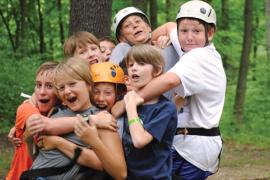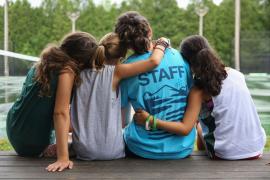We've all seen them — gaggles of teens walking together, each with their eyes glued to the screens of their smartphones, texting, tweeting, and posting. Or that couple in the restaurant with their faces buried in their BlackBerry®, iPhone®, Galaxy® or iPad®. According to the Pew Internet Project update on mobile technology in January 2014, over 90 percent of American adults own a cell phone, though the percentage among staff-age adults ages eighteen to twenty-two is 98 percent. According to the same study, about 82 percent of children twelve to eighteen years of age have a cell phone. Smartphone owners use their handheld mobile computer as a phone only about 30 percent of the time (Rainie, 2012). In her excellent new book on technology and the family, The Big Disconnect, author and psychologist Catherine Steiner-Adair summarizes it well:
"While parents and children are enjoying swift and constant access to everything and everyone on the Internet, they are simultaneously struggling to maintain a meaningful personal connection with each other in their own homes,'' Steiner-Adair writes. "It is the parental paradox of our time: Never has there been so much opportunity for families to plug in and at the same time disconnect."
So how does all this technological preoccupation affect camp, and what can camp directors do about the effects? The first thing to understand is that the effect is ubiquitous. Not only do campers come with a significant "screen attachment" history — according to a Kaiser Family Foundation study, the average ten-year-old looks at a screen between four and seven hours a day (Rideout, 2011) — but their parents and your counselors are all steeped in the mobile technology of smartphones, the Internet, and social media.
The second thing to understand is that the constant distraction of technology has affected the way we interact with one another in person. Just to give one example, Catherine Steiner-Adair tells us that some schools have made their hallways and classrooms cell free precisely because they found that with cell phones present, students weren't making eye contact or even saying hello anymore (Steiner-Adair, 2014)!
Another example is found in the work of Philip Zimbardo, emeritus professor of psychology at Stanford University. He has coined a term he calls the "language of face contact." His studies show that the average teenage boy in the United States plays sixteen hours of video games a week. By the time a boy is twenty-one, he will have played over 10,000 hours of video games. Compare that to the 4,800 hours of study and class time it takes to earn a bachelor's degree or the one-hour-a-week average that a young man spends with his father. As Zimbardo says in sounding the alarm, "Boys don't know the language of face contact — the nonverbal and verbal set of rules that enable you to talk comfortably with another person" — because that language is not taught through video games and smartphones (Zimbardo & Duncan, 2012).
Teenage boys may not be the only ones who have trouble with the "language of face contact." I have heard camp director after camp director share anecdotes about potential staff members they have interviewed who have trouble making or maintaining eye contact. I might add that although using Skype® to interview a potential staff member might be a blessing in that it saves travel time and costs, the language of face recognition is not taught nor detected when using Skype.
One wonders what all this looking at screens rather than people might look like in camp when those same counselors are interacting with campers, especially younger campers who get as much as 75 percent of their information from adults and others non-verbally (Buck, 1975). As one teenager I see in my psychotherapy practice says, "It is a lot easier to text something and just hit the Send button! It's a lot harder to say what you want to say in person!"
The third thing to understand is that both counselors and campers may have less of a sense of what is appropriate when it comes to popular music, personal disclosure, jokes, and other aspects of sharing, because one impact of the Internet is a blurring of boundaries and a normalization of sexualized language and ideas — as in the rise of the "slut-is-chic" trend in much of texting, tweeting, and posting (Steiner-Adair, 2013). As that same teenage patient of mine mentioned, you can text things to other kids that are edgy, provocative, or suggestive because you aren't there to have to deal with the response. "If some kid likes what you've texted, then you're golden. If not, no loss!"
The fourth thing to understand is that the personal connection that comes from truly being present with others is what children — and staff members — need most for personal growth. As I say to thousands of staff members at the beginning of every summer, the most valuable thing you can give someone is your undivided attention. Many people think it is your time. The problem is that you can give your time and not be truly "present" because your true attention is elsewhere, either in your own thoughts or drawn to a screen. A case in point: Last spring I witnessed a young father in a park near my house one Saturday morning with his three-year-old son. He was trying to teach him how to hold and use a Whiffle® ball bat. Instead of making steady and continuous eye contact with his son, the man kept looking at his BlackBerry, and the quality of that interaction clearly suffered as a result.
What Can Directors Do?
The easy answer is outlaw electronics at camp. My concern, however, is that by the time campers and staff get to camp they have already cultivated a lot of bad habits. (The Pew Internet Project update I cited earlier reports that up to 67 percent of smartphone owners check their phones regularly even when they aren't ringing or vibrating. We are addicted!) So what are some proactive steps directors can take to actually restore or revive the habits of personal connection? What can directors do to develop a sense of what is and is not appropriate to share publicly, given that campers and counselors alike have had judgment impaired by all they see on television, the Internet, or in other people's posts on social media?
Let's Start with Staff Training.
NoteTaking
Many directors I know are concerned about the retention rate of information they share with staff about a myriad of critical topics — everything from first aid to lost camper drills to camper medication and the quirks of the daily schedule. What we have learned from a recent study is that when counselors write notes during staff meetings where important information is being shared it can significantly increase their retention of that information. Notice I said write notes. Most college-age counselors type notes onto their laptops or notepads. And who can blame them? Digital notetaking is simply easier.
A paper in the journal Psychological Science, published in April 2014, suggests that longhand note-taking may actually hold an advantage when it comes to remembering what we've heard (Mueller and Oppenheimer, 2014). In their studies, the researchers found that students who took longhand notes performed significantly better on quizzes and tests than students who either used a laptop or notepad or who took no notes at all. Even more surprising is that when students could review their notes a week later, those with longhand written notes performed better than students who took notes electronically. What camp directors rarely do is 1) ask their staff members to take notes and 2) do a debriefing or review of what was heard later in the training day or week. My friend and colleague, Jay Frankel of True-to-Life Training©, routinely asks participants in his trainings to share whatever significant points they've heard at the end of each session. This person-by-person sharing clearly reinforces what participants have heard and can even lead to a rich, deeper discussion afterward.
What is being demonstrated here is the phenomenon of "desirable difficulty," first described by psychologist Robert Bjork twenty years ago. Bjork used the concept to show how making learning harder can also make the information stick. The practice of longhand note-taking runs counter to the purpose of modern technology, which is to streamline, automate, and simplify tasks for us. What we may have unwittingly done in the process is lowered our actual retention. A common, everyday example of this is the use of auto-dialing on our cell phones. As a result of using this convenient feature, most of us do not know the phone numbers of even our closest friends!
One critical detail about longhand note-taking is that it is not fill-in-the-blank! That technique does not give the same boost to retention and is often experienced by staff members as infantilizing. Forcing them to take their own notes, and later debriefing with them as a group, invokes the desired difficulty that actually leads to better retention without them feeling that we are treating them like children.
The Bright Red Line
Another pointer for staff training is the exercise I created called "The Bright Red Line." It is designed to help clarify not only what is and is not appropriate for counselors to share with campers, but what is appropriate for campers to bring into the camp community. Because of the over-stimulating and ubiquitous nature of the Internet and media, children — and staff — are less aware of what is appropriate and what are good "boundaries," especially in the casual environment of a place like camp! This exercise is not for everyone, and it definitely needs to be preceded by a clear agreement about sharing — what gets said in this meeting stays in this meeting! I often talk about the fact that there are things we might discuss as adults or with our closest friends that are not suitable to discuss with the larger public or certainly with children. The problem is that today campers hear things in popular music, on television, and on the Internet that, because of their apparent public nature, are presumed "normal" or fine to share in a casual or public way.
Indeed, when confronted with inappropriate language, many campers have been heard to say, "But my friends and I say this at home all the time!" The key takeaway of "The Bright Red Line" is the phrase counselors can respond with: "What you do or say at home is between you, your parents, and your at-home friends. Here at camp we don't use that phrase; talk about that kind of thing; use jokes or language like that; etc." With consistent prompting, not only do campers begin to get the "house rules" of camp, so does the staff!
For greater effect, hang a red streamer from the ceiling of the front center of the room in which you are meeting. This is the "bright red line" over which we do not cross! Have your staff break into groups of fiver or six per group. Announce the five categories as follows:
- Popular songs
- Movies
- TV shows
- Jokes
- Personal disclosure
Assign one category to each group of counselors. (There may be duplicate groups, such as two groups focusing on jokes, TV, etc.). Each group is to come up with three examples of a song or joke, etc. — one that is appropriate to share with campers, one that is borderline or questionable, and one that is clearly over the "bright red line!" After the groups have had five minutes to brainstorm their answers, they share the appropriate version, the questionable version (or one that might be appropriate with older campers), and the clearly inappropriate version. This can be rather hilarious and results in some red-faced counselors, but it gets the point across: What you might feel comfortable texting, tweeting, or sharing with your fraternity/ sorority friends is not necessarily fair game at camp! The final rule: "If in doubt, don't." If there is a song, show, or movie that campers are talking about that you have questions about, check in with your head counselor or unit director. That is what they are there for!
Co-Counselor Exercise
Another exercise I use in staff training is called simply "Co-Counselors." Very often counselors are thrown together at the whim of the director without any sense of how well a duo is actually going to work together. I have found that counselors have very different levels of tolerance for things like noise levels, chaos or order, organization, and so on. This exercise is designed to help co-counselors assess their tolerances in these four areas:
- Noise level or messiness
- Planning level — going with the flow or planning things out
- Discipline response level — lenient versus strict
- Level of sociability — gregarious versus quiet and shy
Counselors rate themselves individually on a scale from one to four in each category then share their results. If one counselor has a high tolerance for noise or messiness and the co-counselor has a low level of tolerance for the same, there's going to be trouble. One counselor is going to constantly be after the campers to quiet down while the other will be unfazed. Over a week or two, this will wear thin — one counselor will feel he or she is doing all the limit-setting, and the other will feel like he or she has to chill with the kids to compensate. Learning about their differences ahead of time gives co-counselors a chance to have a face-toface conversation about those differences and how to manage them. Not the stuff of Instagram® or Snapchat®!
SMILE ©
Perhaps the most subtle, yet profound change among people steeped in the technology of screens is the loss of eye contact and the subtleties of nonverbal communication. Yet things like eye contact, a hand on the shoulder, or tone of voice are critical in establishing trust with campers and in developing stronger, meaningful connections with them. Indeed, in her article in this issue titled, "Cultivating Camp's Tech-free Traditions in the Digital Age," (Camping Magazine, page 20), Catherine Steiner-Adair urges us to "keep the connection between counselor and camper strong." With all that we throw at counselors during orientation, when the campers actually arrive the counselors are often momentarily at a loss for exactly what to do. I tell them to "SMILE" (1993)! The five things you should tell your staff to do in the first hour, the first day, and the first week of camp are . . .
. . . Say the name of each camper every time you speak to them.
. . . Make eye contact with each of your campers as much as comfortably possible.
. . . Introduce campers to one another by name.
. . . Learn what each camper is looking forward to doing at camp.
. . . Encourage each camper to make a new friend.
These five simple things are the basis for helping to establish the trust and friendships that change lives, that become lifelong, that stand for what camp is about to the millions of people who have had the fortune to attend one. Once we remove the distractions of screens and the ubiquitous call of technology, what we see is our core humanness: the basic human need to feel connected, to feel competent, and to feel seen as an individual. This is what every camp cultivates in the young people — campers and counselors alike — that come back every year for more.
Photos courtesy of Camp Howe, Goshen. Massachusetts.
References
Buck, R. (1975, April). Non-verbal communication in children. Journal of Personality and Social Psychology, 31 (4).
Ditter, B. (1993). SMILE. Lifelines and Safety Nets. Little Fox Productions, Ltd.
Mueller, P., & Oppenheimer, D. (2014, April). Advantages of longhand note-taking in retention and memory. Psychological Science.
Pew Research Internet Project. (2014, January). Mobile technology update. Retrieved from www.pewinternet.org/fact-sheets/mobiletechnology- fact-sheet/.
Rainie, L. (2012). Smartphone ownership update: September 2012. Pew Research & American Life Project. Retrieved from www. pewinternet.org/Reports/2012/Smartphone- Update-Sept-2012.aspx.
Rideout, V., Foehr, U., & Roberts, D. (2011, March). Generation M2: Media in the lives of 8- to 18-year-olds. Henry J. Kaiser Family Foundation.
Steiner-Adair, C. (2013). The big disconnect: Protecting childhood and family relationships in the digital age. HarperCollins.
Zimbarto, P., & Duncan, N. (2012). The demise of guys: Why boys are struggling and what we can do about it. TED Books.
Bob Ditter is a licensed clinical social worker specializing in child, adolescent, and family therapy.
Originally published in the 2014 September/October Camping Magazine.



